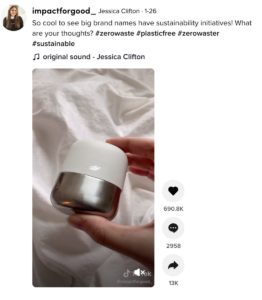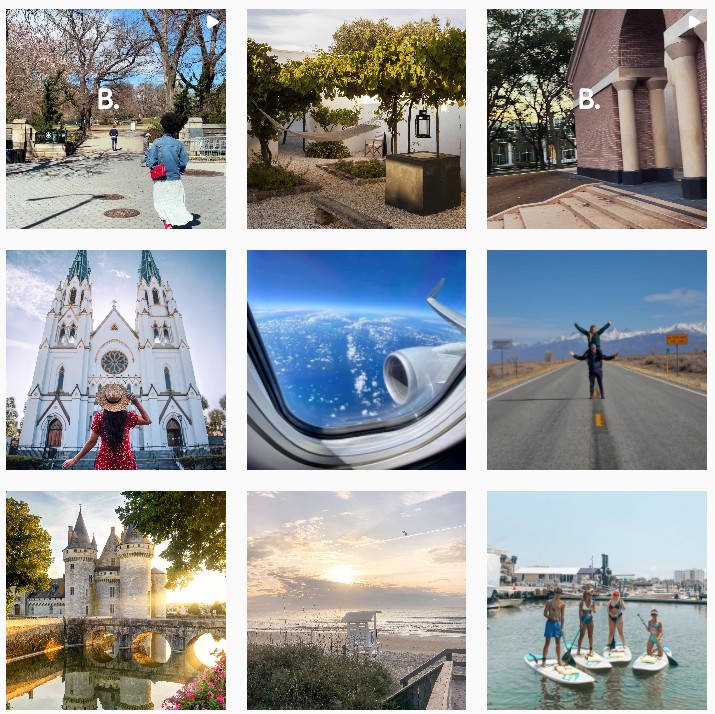This content originally appeared on April 29, 2021 as part of the Future of Marketing weekly email series. Subscribe here.
Welcome to Future of Marketing.
Each week, we send you the most relevant trends, resources, and strategies in social and user-generated content (UGC) from leading marketers and brands around the globe.
Today, we’re discussing:
- Untagged mentions are missed opportunities
- Finding the right mix of content
- #BrandCrush: Booking.com 💘
(Un)tagged mentions
Here’s the thing…
Brands are missing out on user-generated content (UGC). We’re talking untagged UGC, too.
For example, we searched “sustainability” on TikTok (assuming it’d be a hot topic on #EarthDay), and noticed a user raving about Dove’s latest refillable deodorant.
Think about this…
Notice Dove wasn’t tagged in the description, yet they were the main focus of the video. Now, consider the amount of UGC that may go unnoticed by brands (like Dove) because people don’t always tag them.
Why not, you ask?
Social media monitoring company Digimind “discovered that an overwhelming ninety-six percent (96%) of total US retail social brand mentions use brand hashtags, over the brand name.
For global brands, ninety-one percent (91%) of posts included brand hashtags, and only 9 percent directly tagged brand handles.”
Additionally, fifty percent (50%) of consumers wish brands would tell them what type of content to share, which means there are communication gaps brands need to fill.
TIP: Try adding a hashtag to your social media bio(s), website, or packaging (if applicable) to guide fans, and subconsciously teach them where and how to share content or testimonials about your brand.
Sentiment drives conversions
If marketing amid a pandemic taught us anything, it’s this: consumers have high expectations for brands.
Now, airlines are reducing carbon emissions. Consumer goods are switching to eco-friendly packaging. And brands on social media are becoming more… social.
 To understand what your audience resonates with, you need the right mix of content to engage and build trust with customers, prospects, and employees. After all, sentiment drives engagement and conversions.
To understand what your audience resonates with, you need the right mix of content to engage and build trust with customers, prospects, and employees. After all, sentiment drives engagement and conversions.
Start with a 50/50 community voice (UGC) and brand voice split. This will help you identify what content your audience most (and least) resonates with.
Here are some examples of UGC you can experiment with:
- Customer stories
- Q&As
- Polls
- Testimonials
- Giveaways
- Contests
- Unboxing videos (if applicable)
Then, mix UGC with brand content, including:
- Tutorials
- FAQs
- Behind-the-scenes
- Employee-generated content (EGC)
Once you understand what’s working (based on your data), double down on it. Better yet, if it worked well on one platform, reformat your content to distribute across other marketing channels and expand reach.
What we’re learning
#BrandCrush: Booking.com 💘
Each week in #brandcrush, we highlight exceptional brands that are channeling their customers’ voice to connect more authentically with their audience.
As different parts of the world prepare for a safe return, Booking.com is sharing travel stories by people around the world – from influencers to fans.
For example, Booking.com launched its Where in the world Instagram series, where they strolled the streets of London to quiz random passersby.
The company is also running a #BackToTravel campaign where influencers are sharing their travel stories to encourage fans to tag their adventures. This creates more UGC for the brand, which can be repurposed to save time, money, and increase conversions.
Booking.com’s interview series and #BackToTravel hashtag are just two examples of creative campaigns you can experiment with to understand what your audience is more receptive to… because as Tom Fishburne once said, “the best marketing doesn’t feel like marketing.”
Until next week. 👋🏼

